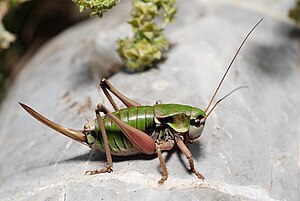Alpine horror
| Alpine horror | ||||||||||||
|---|---|---|---|---|---|---|---|---|---|---|---|---|

Alpine horror ( Anonconotus alpinus ), female |
||||||||||||
| Systematics | ||||||||||||
|
||||||||||||
| Scientific name | ||||||||||||
| Anonconotus alpinus | ||||||||||||
| ( Yersin , 1858) |
The alpine insect ( Anonconotus alpinus ) is a long- probe insect from the superfamily of the leaf locust (Tettigonioidea).
features
The female reaches a body length of 18 to 23 millimeters, the male is between 16 and 21 millimeters long. The slightly upwardly curved ovipositor of the females becomes a further 11 to 16 millimeters long and is greenish or reddish, darker in color towards the tip. Both sexes differ only slightly in terms of color. Their body has a very variable basic color, ranging from a strong green to olive green and gray to red-brown. Most of the animals have blurred, black areas on the head, the sides of the pronotum and the abdomen, which together form a longitudinal band, but which dissolve into individual spots on the sides of the abdomen. Occasionally evenly colored individuals appear. The lower head area is like the belly light gray to beige, the upper sides of the head and pronotum are mainly green, the pronotum lobes are lined with light yellow at the lower edge. The light brown antennae are only about as long as the body and darkened towards the tip. The compound eyes are black. The pronotum is extended backwards and porous on top. The abdomen is short and stocky. The light yellow wings have receded to very short stumps and are 1.5 to 3 millimeters long in the male and 0.5 to 1 millimeter long in the female. The two pairs are visibly separated in the females, in the males they overlap and are brown in color on the front, which is usually covered by the pronotum. The pink or light brown colored legs are relatively short and strong. The knees are black. The cerci of the males are curved inward and taper to a short spine.
Occurrence
The alpine hermit only occurs in the Alps . The main distribution area is on the one hand in the Eastern Alps from the Puster Valley to East Tyrol , on the other hand in the Western Alps from the Bernese Alps to Mont Ventoux in Provence . An isolated occurrence is from the Arlberg in St. Anton known another at Monte Baldo on Lake Garda is only historically proven. They are found at altitudes in alpine and subalpine mountain areas between 1,800 and 2,300 meters, but in places also around 1,200 meters above sea level, such as in the southwestern Alps. The species prefers to colonize temperature-favored alpine pastures and dwarf shrub heaths with gappy vegetation and juniper growth on stony ground.
Way of life
The adults appear from July to October, the maximum is at the end of August. They live on the ground and mostly sit in low grass or on gravel. They feed mainly on herbivores , but also eat insects. The larvae only hatch after two overwintering periods and go through seven larval stages.
singing
Their singing is largely in the ultrasound range and is therefore almost imperceptible to humans. It consists of a short, about a second long, whirring sung at irregular intervals. During the pairing, “ttttt” sounds are also generated.
swell
literature
- Bertrand & Hannes Baur, Christian & Daniel Roesti: The locusts of Switzerland . Haupt Verlag, Bern 2006, ISBN 3-258-07053-9 .
- Heiko Bellmann : The cosmos of locust leaders, defining the types of Central Europe with certainty . Franckh-Kosmos Verlags-GmbH & Co KG, Stuttgart 2006, ISBN 3-440-10447-8 .